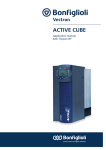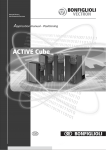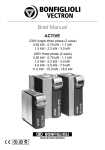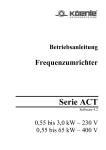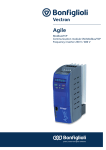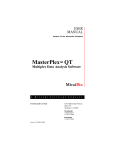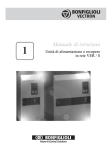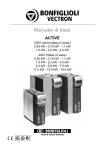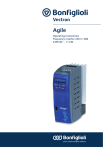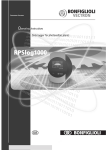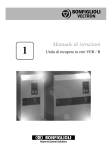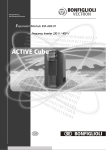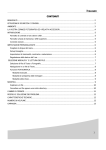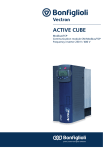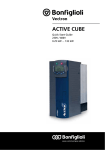Download Safe Torque Off
Transcript
ACTIVE CUBE Application manual - Safe Torque Off Bonfiglioli has been designing and developing innovative and reliable power transmission and control solutions for industry, mobile machinery and renewable energy applications since 1956. www.bonfiglioli.com Bonfiglioli Riduttori S.p.A. Via Giovanni XXIII, 7/A 40012 Lippo di Calderara di Reno Bologna, Italy tel: +39 051 647 3111 fax: +39 051 647 3126 [email protected] www.bonfiglioli.com VEC 541 R2 / ACU-STOV1-01SV2-03 en General Information about the Documentation This application manual complements the operating instructions and the „Quick Start Guide“ of the ACU frequency inverters (ACTIVE Cube series). It contains all relevant information required for using the safety-oriented function „Safe Torque Off“ (STO). For better clarity, the documentation is structured according to the customer-specific requirements made on the frequency inverter. Quick Start Guide The Quick Start Guide describes the basic steps required for mechanical and electrical installation of the frequency inverter. The guided commissioning supports you in the selection of necessary parameters and the software configuration of the frequency inverter. Operating Instructions The Operating Instructions describe and document all functions of the frequency inverter. The parameters required for adapting the frequency inverter to specific applications as well as the wide range of additional functions are described in detail. Application Manual The application manual supplements the documentation for purposeful installation and commissioning of the frequency inverter. Information on various subjects connected with the use of the frequency inverter is described specific to the application. Installation Instructions Complementing the Brief Instructions and the Operating Instructions, the Installation Instructions provide information on how to install and use the additional/optional components. If you need a copy of the documentation or additional information, contact your local representative of BONFIGLIOLI. The following pictograms and signal words are used in the documentation: Danger! Danger refers to an immediate threat. Non-compliance with the precaution described may result in death, serious injury or material damage. Warning! Warning refers to a possible threat. Non-compliance with the warning may result in death, serious injury or material damage. Caution! Caution refers to an immediate hazard. Non-compliance may result in personal or material damage. Attention! Attention and the related text refer to a possible behavior or an undesired condition which can occur during operation. Note marks information which facilitates handling for you and supplements the corresponding part of the documentation. ACU-STOV1-01SV2-03 en 03/11 3 TABLE OF CONTENTS 1 General Safety Instructions and Information on Use .................................................... 5 1.1 Safety Instructions on Function „Safe Torque Off“ (STO) .......................... 5 2 Information of Risk Analysis and Risk Assessment ....................................................... 7 3 General Description of Safety Function ......................................................................... 8 4 5 3.1 Integrated Safety Function ......................................................................... 8 3.2 Functional Safety ........................................................................................ 8 3.3 Classification the safety requirement ......................................................... 8 Description of ACTIVE Cube Safety Function ................................................................. 9 4.1 Two-Channel Monitoring .......................................................................... 10 4.2 Diagnosis function and enforced dynamizing ........................................... 12 4.3 Diagnosis indicators .................................................................................. 13 Requirements to be met by installation....................................................................... 14 5.1 Instructions on installation of safety equipment ..................................... 14 5.2 External Safety Control Equipment .......................................................... 15 5.3 External DC 24 V power supply ................................................................ 15 5.4 DC 24 V Power supply by ACU .................................................................. 16 6 Requirements to be met in operation .......................................................................... 16 7 Requirements to be met by acceptance inspection ..................................................... 16 8 Application Examples ................................................................................................... 17 9 8.1 Direct Stop, Stop Category 0 .................................................................... 18 8.2 Direct Stop with Feedback to PLC, Stop Category 0 ................................. 19 8.3 Direct Stop, Stop Category 1 .................................................................... 20 8.4 Direct Stop with Feedback to PLC, Stop Category 1 ................................. 21 8.5 Internal DC 24 V Supply, Stop Category 1 ................................................ 22 8.6 Group Stop, Stop Category 1 .................................................................... 23 8.7 Error exclusion “short circuit” in the cabinet ........................................... 24 Checklist ....................................................................................................................... 25 10 Safety Function Test Report......................................................................................... 26 11 STO status (diagnosis) ................................................................................................. 26 12 Index of Change ........................................................................................................... 27 4 ACU-STOV1-01SV2-03 en 03/11 1 General Safety Instructions and Information on Use The present documentation was prepared with great care and it was subjected to extensive and repeated reviews. For reasons of clarity, it was not possible to include all details of all types of the product in the documentation. Neither was it possible to consider all conceivable installation, operation or maintenance situations. If you require further information or if you meet with specific problems which are not dealt with in sufficient detail in the documentation, contact your local BONFIGLIOLI agent. We would also like to point out that the contents of this documentation do not form part of any previous or existing agreement, assurance or legal relationship. Neither are they intended to supplement or replace such agreements, assurances or legal relationships. The manufacturer's obligations are exclusively specified in the relevant purchase contract. This contract also contains all and any warranty regulations which may apply to the relevant scope of supply. These contractual warranty provisions are neither extended nor limited by the specifications contained in this documentation. The manufacturer reserves the right to correct or amend the specifications, product information and omissions in these operating instructions without notice. The manufacturer shall not be liable for any damage, injuries or costs which may be caused by the aforementioned reasons. Warning! The specifications and instructions contained in the documentation must be complied with strictly during installation and commissioning. Only qualified staff who has read and understood the documentation is allowed to carry out installation or commissioning work or to operate the devices. The safety instructions must be complied with strictly. The term „Qualified Staff“ refers to anybody who is familiar with the installation, assembly, commissioning and operation of the frequency inverter and has the proper qualification for the job. The present documentation complements the operating instructions ACTIVE Cube (ACU). It contains additional safety information and requirements for the operation or ACTIVE Cube (ACU) in safety-oriented applications. Use in safety-oriented machines shall be permissible only after this documentation has been read carefully and understood. The applicable basic standards as well as application-specific and specific national standards shall also be complied with – the standards referred to in this manual shall also be complied with. This documentation was written in german language. Other language versions are translated. Copyright: This user manual is protected by copyright. It is solely intended for use by operating staff and must not be copied nor disclosed to third parties. 1.1 Safety Instructions on Function „Safe Torque Off“ (STO) The function „Safe Torque Off“ (STO) is a functional safety provision, i.e. it protects staff from damage, provided that projecting, installation and operation are performed properly. This function does not disconnect the machine from power supply. The safety function “Safe torque off” (STO) can be used to realize an “Emergency Stop” while the power supply is still active on the frequency inverter. According to EN 60204 a provision must be provided for disconnecting the machine from power supply for maintenance work. ACU-STOV1-01SV2-03 en 03/11 5 Warning! Improper installation of the safety technique can cause an uncontrolled starting of the drive. This may cause death, serious injuries and significant material damage. Safety functions may only be installed and commissioned by qualified staff. The STO function is not suitable for emergency switch off as per EN 60204. An emergency switch off can be realized by installing a mains contactor. An emergency stop according to EN 60204 must be functioning in all operation modes of the frequency inverter. Resetting of an emergency stop must not result in uncontrolled starting of the drive. The drive is started again when the function STO is no longer triggered. In order to comply with EN 60204, it must be ensured by taking external measures that the drive does not start without prior confirmation. Without a mechanical brake, the drive might not stop immediately but coast to a standstill. If this may result in personal or material damage, additional safety measures must be taken. If persons may be endangered after disconnection of the motor control by STO, access to the hazard areas must be prevented until the drive has stopped. Check the safety function at regular intervals according to the results of your risk assessment. BONFIGLIOLI VECTRON recommends that the check is performed after one year, at the latest. The STO function is one fault fail-safe. No single fault or component failure can cause a disabled drive to produce motor shaft torque. Only in extremely unlike combinations of component faults the motor shaft could move jerky with sudden acceleration (maximum 180°/number of pole pairs, for example jerky movement of 90° for 4-pole motor, 180°/2) and produce torque. It must be checked if this behavior can cause a dangerous machine movement. If the STO function is used, the special safety, installation and instructions on use instructions shall be complied with. Warning! Dangerous voltage! After disconnection of an external DC 24 V power supply, the DC link of the frequency inverter is still connected to mains supply. Even if the motor control is deactivated and the motor is coasting to a standstill or has already stopped, high voltages may still be present on the motor terminals. Before working (e.g. maintenance) on live parts, the machine must always be disconnected from mains supply (main switch). This must be documented on the machine. When the function “Safe Torque Off” is triggered, the motor is not isolated from the DC link of the frequency inverter. High voltage levels may be present at the motor. Do not touch live terminals. 6 ACU-STOV1-01SV2-03 en 03/11 2 Information of Risk Analysis and Risk Assessment According to the Directive on Machinery 98/37/EC, the manufacturer of a machine is obliged to carry out a risk analysis in order to identify the hazards related to the machine. The Standard EN 14121-1 – Safety of machinery - Risk assessment – Principles – describes the information required for risk assessment. Risk assessment is effected according to the following criteria: − degree of injury (serious/minor) − frequency or duration of stay (frequent/seldom) − possibilities of avoidance (hardly possible/possible) For defined risks the Standards EN ISO 13849-1, IEC 61508 or EN 954-1 can be used to accomplish a correct classification into Safety category, SIL (Safety Integrated Level) or PL (Performance Level). These standards contain design principles for safety-relevant parts of control systems. In the case of the safety function “Safe Torque Off”, the risk assessment must consider the fact that the motor will coast to a standstill in the case of an error. Depending on the application, a mechanical brake may be required. Responsibility: The Manufacturer shall be responsible for the safety of the machine. − risk analysis of hazards originating from the machine − measures for reduction and elimination of the risks − documentation of residual risk from the point of view of the manufacturer − selection of suitable controller, installation of protective equipment, ergonomics, documentation, warning of remaining risks The operator of the machine is responsible for the safety of the application. − risk analysis of hazards originating from the use of the machine − documentation of residual risk from the point of view of the operator − safe operation and protection of operating staff (barriers, instruction of operating staff, etc.) Selection of safety function: − Risk analysis and risk assessment for machine (standards EN 12100-1, EN 12100-2 and EN 14121-1) − Risk reduction by machine design − If not possible by design: risk reduction by protective equipment − Identification of safety requirements − Selection of category of safety function - PL d according to EN ISO 13849-1 - SIL 2 according to IEC 61508 - Category 3 according to EN 954-1 Note: ACU-STOV1-01SV2-03 en 03/11 The Standard EN954-1 is replaced by the standard EN ISO 13849-1. The legislator has rescheduled the transition period from 11-30-2009 to 1231-2011. 7 3 General Description of Safety Function 3.1 Integrated Safety Function Electronic protection systems are integrated in the drive control system and perform safety functions in order to minimize or eliminate hazards caused by functional errors of machines. The integrated safety functions replace time-consuming and expensive installation of external safety components. The safety function can be requested or triggered by an error. In hazard areas, setup work or work for elimination or errors may be required where the safety function is not to be activated by isolating protection devices such as mains contactors or motor contactors. Here, the additional safety function may be used. STO can be used as an alternative to mains or motor contactors, which can be omitted dependent on the application. The integrated safety functions reduce the risk of personal damage in hazard areas and reduce installation requirements. 3.2 Functional Safety The safety function of the control system must be ensured for normal, trouble-free operating sates as well as in the case of an error. As a result of this requirement: − The safety function must be checked in case errors are present. Possible methods include: error tree analysis, FMEA, etc.). 3.3 Classification the safety requirement The integrated safety function “Safe Torque Off” of the ACU frequency inverter meets the following requirements: − up to safety integrity level SIL 2 according to DIN EN 61508 for STO (STO, Safe Torque Off according to EN 61800-5-2) − of category 3 according to DIN EN 954-1 (safe stop) − up to performance level d according to EN 13849-1 In the case of an error, thanks to the safety function STO, the frequency inverter does not supply energy to the motor which would cause a revolution or torque (or a movement or force in the case of a linear motor). Characteristic for the classification mentioned above: − If an error occurs, the safety function is maintained. By using appropriate safety control devices, stop category 0 and stop category 1 according to EN 60204 can be achieved in the machine. For safety control devices, please refer to chapter 8. Stop category 0: Stop by immediate disconnection of energy supply to the machine drive elements, i.e. uncontrolled stop. Stop category 1: Controlled stop, where energy is still being supplied to the drive elements of the machine to perform the stopping operation. Energy supply is stopped only after the drive has come to a standstill. Note that the drive may not stop immediately but coast to a standstill. If no mechanical brake is installed, or a defective brake may involve a risk, further protective measures (in example tumbler) are to be taken. 8 ACU-STOV1-01SV2-03 en 03/11 4 Description of ACTIVE Cube Safety Function The frequency inverters of the ACU series of devices feature the integrated safety function „Safe torque off, STO“. In the case of an error or if requested, the power semiconductors of the frequency inverter will be switched off. After this, the frequency inverter does not supply energy to the drive which would cause a revolution or a torque (or a movement or force in the case of a linear drive). Mains voltage is still present. The function STO can be used, for example, for safe stopping in the case of a dangerous situation or for maintenance work on the machine. If an error occurs, the machine can still be (or remain) switched off safely. Unlike shut-down via mains contactors or motor contactors, the integrated safety function enables easy combination of drives in a machine to form functional groups. The Safe Torque Off can be limited to certain plant areas in this way. Another advantage is the fact that it is not necessary to wait until the frequency inverter has been charged and discharged. Thus, readiness of the machine for operation can be restored more quickly. Regular electro mechanic equipment are wearing out – through the usage of the STO functionality, this kind of equipment is no longer necessary and maintenance costs can be reduced. Safe Torque Off: − Energy supply for the rotary field of the motor is interrupted; the motor coasts to a standstill − Used if monitoring for standstill is not required − Accidental start of the motor is prevented − No galvanic isolation of motor from frequency inverter DC link Traditional System Mains Frequency inverter Integrated System with ACU and usage of STO Mains ACTIVE Cube with integrated Safety function Safe Torque Off K1 M M Further advantages: − Contactors on motor side not required, reduced installation requirements, less components, more space in electrical cabinet − Simple realization with external safety control device − The drive can be connected to power supply continuously; communication and parameter configuration of the frequency inverter are maintained while the torque is disabled. − Easier machine approval, because the safety function is certified via a type examination check. ACU-STOV1-01SV2-03 en 03/11 9 Triggering of function “Safe Torque Off” Safe Torque Off can be achieved by: − Intentional triggering during operation in order to stop a drive and safely prevent restarting, e.g. for maintenance work on a machine. − Triggering by actuation of an emergency stop switch or monitoring of protective systems, e.g. safety door. − Detection of an error. The drive may only start again after the error has been acknowledged and eliminated. Actuation of safety relay Safe Torque Off Detection of an error through self-diagnosis Application example: The danger zone near a transport conveyor is monitored by a light grid. If anybody enters the danger zone, the light grid is interrupted. The DC 24 V supply for the digital inputs STO of the function „Safe Torque Off“ is switched off and the frequency inverter output stage is disabled. The drive coasts to a standstill. Disconnection from mains supply is not necessary. Communication via field bus or addressing via the terminals is still possible. An external brake which stops the motor can be addressed. 4.1 Two-Channel Monitoring The STO function (Safe torque off) is realized via two channels in the frequency inverter (redundant design). Via two redundant monitored stop paths with no-voltage release (STOA and STOB), the frequency inverter is switched off safely even if an error occurs and the control voltage fails at the same time. Thus, the drive is stopped safely if an error occurs. An error is identified and can then be repaired (e.g. by replacing of a unit). Triggering can be effected, for example, via a two-channel contactor control with two release circuits and redundant disconnection of the main current or via a sensor or emergency stop switch with two contacts and separate cable routing to the evaluation unit. The stop paths are monitored cyclically every 32 ms. Both stop paths are designed identically. Via the digital inputs S1IND (STOA) and S7IND (STOB), two DC 24 V control voltages of a protection device are applied. If the protection device is actuated, the control voltages are interrupted and the pulse block is activated; energy supply to the motor is switched off. Disconnection is effected at a delay of less than 10 ms. If the function STO is triggered, the overriding controller has no more influence on the pulse block1 in the frequency inverter. To restart, the pulse block has to be reset and a release commanded by the operator or the superior PLC. One single error will not result in a failure of the safety function. 1 If the pulse block is set, the controller release is reset. If the pulse block is set, no motor revolving field is generated. ACU-STOV1-01SV2-03 en 10 03/11 Stop paths Mains S1IND (STOA) S7IND (STOB) µC M PWM Diagnosis and monitoring Control unit Power unit The test required for monitoring is performed by the frequency inverter automatically. If the test results negative, the frequency inverter cannot be switched on anymore. Starting is possible again only after the error has been repaired and the next test has been completed successfully. Truth table In the truth table, the states of the safety-relevant inputs STOA and STOB for activation and deactivation of the safety function STO are listed. STOA STOB 0 0 0 1 1 0 1 1 Truth table Description of state Safety function “Safe Torque Off” (STO) has been triggered. The frequency inverter signals no error in STO function. STO is triggered. Monitoring for error in frequency inverter or external circuitry (5-second monitoring). After 5 seconds, an error is signaled. STO is not triggered. Release for operation. 5-second monitoring It will be checked if the two inputs STOA or STOB are switched on within an interval of less than 5 sec for requesting the release of the frequency inverter output stages. If function STO is triggered by removing one of the signals from inputs STOA or STOB, the status changes to “STO triggered”. Now, the unit waits that both inputs are switched off. If this has not been done within 5 s after occurrence of this state, an error is triggered (5-second monitoring). If, during operation, an error is detected, the output stage is switched off, the release is reset (“0”) and the frequency inverter signals an error. This status can only be left by switching off (“0”) the two release inputs STOA and STOB. − Different signal states on inputs STOA or STOB start the 5-second monitoring − Within 5 seconds, the same signal must be present of both inputs, otherwise an error will be signaled (F1205) The function of external installation can be checked via the “5-second monitoring” by actuating the protection device. ACU-STOV1-01SV2-03 en 03/11 11 Behavior of frequency inverter after start − Initialization − Monitoring for release request (5-second monitoring) − Preparation of release (check of stop paths) − Release of frequency inverter Behavior of frequency inverter in the case of an error − Switch off of IGBT in power output stage by disconnection of optocoupler supply voltage − Suppression of control pulses of IGBT − Setting of error bit with possibility of transfer to overriding controller − Setting of digital output for error message − Release of digital input for error acknowledgement. 4.2 Diagnosis function and enforced dynamizing The two stop paths are monitored by the frequency inverter every 32 ms. If at least one of the two inputs S1IND (STOA) or S7IND (STOB) is switched off, the pulse block is activated. Additionally, a 5-second monitoring cycle begins for the other stop path. If this path is not stop within 5 s, error F1205 is output. The test required for monitoring the stop paths is performed by the frequency inverter automatically. Via automated enforced dynamizing, the stop paths are checked for errors. If the test result is negative, the frequency inverter cannot be switched on anymore, and error F1201 is signaled. Starting is possible again only after the error has been repaired and the next diagnosis cycle has been completed successfully. 12 ACU-STOV1-01SV2-03 en 03/11 Sequence of release and monitoring states depending on signals on control inputs STOA and STOB: STOA STOB Diagnosis ok ok ok ok ok ok ok ok fault ok fault fault Diagnosis Enable Monitoring 0 1 2 3 0 1 2 4 (Diagnosis fault) t/ms 32 STOA STOB Diagnosis ok ok ok Diagnosis Enable 4 0 1 2 3 Monitoring 32 304 Monitoring states 0: Monitoring of Enable Actuation 1: Preparation Enable 2: Enable 352 (5 s monitioring) 5260 4 0 t/ms 5308 3: Actuation of STO 4: Fault Diagnosis fault: Only if 2 consecutive faults are recognized, the monitoring function reports a fault. 5 s Monitoring: Checks, if both inputs STOA and STOB are switched on within 5 s from each other. In order to achieve robust operation and, for example, exclude electromagnetic interference in the signal assessment of the diagnosis function, the diagnosis is repeated when an error is detected. The frequency inverter is switched over only if another error is detected by the diagnosis function in operation status “STO Enable”. Before the frequency inverter output stages are released: − Check if STOA and STOB are switched on less than 5 s after one another (5s monitoring). If this is the case, the release is prepared. − Diagnosis for error in stop paths STOA and STOB. If no error is detected in the stop paths and release has been prepared, the output stages are enabled. 4.3 Diagnosis indicators The LEDs of the frequency inverter indicate if the safety function is activated properly. green LED red Off On Flashing On On Flashing Off Off ACU-STOV1-01SV2-03 en 03/11 Off On Off Off Flashing Flashing Flashing On Description No supply voltage, unit is off Initialization and self-test Operation mode Operating message Warning message in operation Ready for operation and warning message Fault message Error message can be acknowledged Rotary field on motor No No No Yes Yes No No No 13 5 Requirements to be met by installation 5.1 Instructions on installation of safety equipment − If work is to be carried out on live components, it must be possible to disconnect the machine from mains supply by means of a main switch. − According to EN 61800-5-2 a fault exclusion can be considered with one of the following possibilities: o The conductor is installed permanently and in example protected against external damage with a cable duct or reinforcement. o Single multi-conductors are used. o The conductors are situated in an electrical cabinet. o The conductors are shielded independently and have grounding. If applicable, the requirements of EN 60204-1 have to be considered to install the connectors correctly. − Protection against dirt is ensured if the ACTIVE Cube frequency inverters and safety control equipment is installed in electrical cabinets with high IP protection, e.g. IP 54. − If external forces act on the drive axis, e.g. in the case of vertical axes (suspended loads) or round axes with asymmetrical weight distribution, mechanical brakes must be installed additionally. − Only use voltage sources with safe disconnection (SELV/PELV) according to VDE0100. Comply with the specifications in chapter 5.3. The ACTIVE Cube frequency inverters must not be supplied with pulsed signals. Cross fault detection via pulsed signals cannot be used for this reason. Errors can be excluded in the case of the ACTIVE Cube units because the terminal blocks for the STO function are physically separate from one another. The signal cables between the safety control equipment and ACTIVE Cube must either be physically separate from one another or suitable, cross fault proof cables. − − Comply with applicable EMC instructions mentioned in the operating instructions. − After installation, check the safety function and error reaction and issue an acceptance report. − Interrupting the STO signals prevents a start of the motor. According to EN 60204-1, STO must not be released during an impending endangerment. − Also comply with the instructions on external safety control equipment. − During commissioning, check the safety function. Select the dimensions of the safety application such that 14 mA input current is available for each of the inputs STOA and STOB. If more than one ACTIVE Cube frequency inverters are connected to one safety control device, the safety control device must provide sufficient power for all of them. 14 ACU-STOV1-01SV2-03 en 03/11 5.2 External Safety Control Equipment Safety control equipment, upon request (e.g. actuation of emergency stop or access to hazard area, must trigger appropriate responses in order to protect people, the machine and the environment. They evaluate sensor signals or safely switch off dangerous states. External safety control devices must meet the following requirements: − External safety control equipment and safety modules for control of the digital inputs (STO) must meet one of the following classifications, to meet the classification of the ACU device: o PL d according to EN ISO 13849-1 o SIL 2 according to IEC 61508 o Category 3 according to EN 954-1 o the whole installation meets these requirements − The switching capacity of the safety control equipment must be designed for the maximum permissible, limited output current of the DC 24 power supply. Comply with the instructions of the manufacturer of the safety control equipment on the permissible contact load and any safeguards to be provided for the safety contacts. − The emergency stop device must comply with Standard EN ISO 13850. − If a safety request (e.g. emergency stop actuated or sensor signals that safety door is open) is reset (emergency stop unlocked, safety door closed) this alone shall not result in a restart of the drive. Restart may only occur after the safety control device has been reset. External safety control devices evaluate sensors: Examples of contact sensors: − Emergency stop control device for stop in dangerous situations − Position switch, e.g. for monitoring slide doors, safety grids or moving machine parts Examples of no-contact sensors: − Light barriers, e.g. for monitoring areas with dangerous movements − Light curtains 5.3 External DC 24 V power supply During projection and installation of a DC 24 V supply connected to the frequency inverter comply with the following instruction. This also includes supply of a safety control device the output of which is connected to a control input (including STOA and STOB) of the frequency inverter. Attention! Use a suited SELV/PELV voltage supply, which rated voltage has to be DC 24 V ±10 %. The largest overvoltage must not exceed DC 32 V in the case of a fault (one fault safety). The one fault safety has to be realized with an overvoltage protection of the mains supply (overvoltage protection OVP with limiting the output voltage to a maximum of DC 32 V) or an external wiring like a Crowbar. An adequate overvoltage category of the voltage supply has to be ensured. ACU-STOV1-01SV2-03 en 03/11 15 5.4 DC 24 V Power supply by ACU You can use terminal X210A.1 in order to supply a safety control device. Only use the power supply for the device connected to the frequency inverter. Other safety control devices must not be connected. The maximum output current is 180 mA. The connected device must not have higher current requirements. 6 Requirements to be met in operation During operation, the projected and commissioned machine components must not be changed. If the machine is modified a new acceptance inspection is required. Check the safety function at regular intervals. The test intervals are to be determined according to the risk analysis. However, the check should be performed once every year, at the latest. 7 Requirements to be met by acceptance inspection The acceptance inspection of the safety function is ordered by the manufacturer of the machine. The inspection (acceptance) shall be performed by a properly qualified person. The result of the inspection is to be documented and must be signed by the inspector. Each safety function must be documented in detail in this report. The inspections also include the machine documentation, including its safety functions. The safety functions must be checked particularly during the inspection and documented in the inspection report. Parameter settings shall be attached to the report. Further documents shall be added, as required, depending on the machine. Depending on the result of the risk analysis, inspection reports of the regular inspections shall be issued and signed by the inspector. 16 ACU-STOV1-01SV2-03 en 03/11 8 Application Examples The following examples illustrate how the “Safe Torque Off” function works. According to EN 60204, stop functions are divided in different categories. By suitable safety control devices, stop categories 0 and 1 can be realized in combination with the frequency inverter ACU. Stop category 0: Stop by immediate disconnection of energy supply to the machine drive elements, i.e. uncontrolled stop. Stop category 1: Controlled stop, where energy is still being supplied to the drive elements of the machine to perform the stopping operation. Energy supply is stopped only after the drive has come to a standstill. Stop functions must always have priority over start functions and must work properly in any operation mode. Resetting of the stop function must not cause any dangerous state. The mechanical elements must be dimensioned properly for the stop category used. If, for example, a mechanical brake is applied in the case of fast-rotating machines via stop category 0, this brake must be able to stop the machine safely. Wear and tear of the mechanical elements must be considered during projection for the operating states and indicated in the maintenance instructions. Stop category 0 always has priority over stop category 1. ACU-STOV1-01SV2-03 en 03/11 17 8.1 Direct Stop, Stop Category 0 The application example shows the minimum circuitry for ACTIVE cube frequency inverters for realization of the safety function STO “Safe Torque Off” with an emergency stop device in a common electrical cabinet. If the emergency stop device with two stop channels according to EN ISO 13849-1 PL d, IEC 61508 SIL 2 or EN954-1 Category 3 is actuated, both stop paths STOA and STOB of the ACTIVE Cube frequency inverter are interrupted and the integrated safety function with safe pulse block with SIL 2 according to EN-61800-5-2 is activated. A (non-safe) feedback to a process controller can be effected, for example, via a connected field bus. If STO is requested, the overriding controller has no more influence on the pulse block in the frequency inverter. Note: Terminal X210A.1 can be used for DC 24 V supply of the safety control unit. Please note the current capacity of the frequency inverter (and the current requirements of the safety control device. Mains Field bus +24 V Safety control equipment 1 2 3 4 5 6 7 STOA ACTIVE Cube X210A +E20V GND S1IND S2IND S3IND S4IND S5IND X310 Field bus connection X210B S6IND S7IND S1OUTD MFO1A 10VRef MFI1 GND X10 1 S3OUT.1 2 S3OUT.2 3 S3OUT.3 1 2 3 4 5 6 7 STOB Safety circuit +24V Relay S3OUT Electrical cabinet M STOA: first shutdown path of the safety function STO STOB: second shutdown path of the safety function STO X210A, X210B, X10: Control terminals of the frequency inverter X310: Interface of communication module +E20V: DC 20 V voltage output or input for an external DC 24 V voltage supply Terminal X210A.2 : Earth 20 V/ Earth 24 V (ext.) S1IND ... S7IND: Digital inputs S1OUTD: Digital output MFO1A: Multi-function output (analog/digital, frequency signal) 10VRef: Reference voltage DC 10 V MFI1A: Multi-function input (analog/digital) Terminal 210B.7: Earth 10 V X10: Relay output 18 ACU-STOV1-01SV2-03 en 03/11 8.2 Direct Stop with Feedback to PLC, Stop Category 0 The application circuit shows a drive control system according to EN ISO 13849-1 PL d, IEC 61508 SIL 2 or EN 954-1 category 3 with PLC and safety module. A PLC performs the process control of the frequency inverter and can start the drive profiles via commands. If the protective device is actuated, e.g. safety door open, the enable paths of the safety module are interrupted. As a result, the controller enable signal of the frequency inverter is interrupted via the disconnection of the control voltages from STOA and STOB and the integrated safe pulse block is activated. The safety module monitors the function of the switches S1 and S2 which are located outside of the electrical cabinet. Safety installation opened closed Mains S1 S2 Safety control equipment PLC Acknowledgment X210A ACTIVE Cube 1 +E24V 2 GND STOA 3 S1IND Start CW Start CCW 4 S2IND 5 S3IND 6 S4IND 7 S5IND X210B 1 S6IND STOB 2 S7IND Speed Set value 3 S1OUTD 4 MFO1A 5 10VRef 6 MFI1A 7 GND X10 Relay 1 S3OUT.1 Feedback +24V 2 S3OUT.2 S3OUT 3 S3OUT.3 Eletrical cabinet Position switch displayed actuated ACU-STOV1-01SV2-03 en 03/11 M 19 8.3 Direct Stop, Stop Category 1 The application example shows the minimum circuitry for ACTIVE cube frequency inverters for realization of the safety function STO “Safe Torque Off” with an emergency stop device in a common electrical cabinet. When the emergency stop device is actuated, the travel command “Clockwise” is reset first. After a delay tv, the contacts on the safety switch interrupt the two enable paths STOA and STOB of the ACTIVE Cube frequency inverter and the integrated safety function is activated. The delay time is set on the safety control device and must be selected according to the application. The set delay time has to be higher than the shut down time. A (non-safe) feedback to a process controller can be effected, for example, via a connected field bus. If STO is requested, the overriding controller has no more influence on the pulse block in the frequency inverter. Safety installation opened closed S1 Mains S2 Field bus +24 V Safety control equipment tv STOA Acknowledgment Start CW STOB Safety circuit +24V ACTIVE Cube X210A +E20V GND S1IND S2IND S3IND 6 S4IND 7 S5IND 1 2 3 4 5 X310 Field bus connection X210B S6IND S7IND S1OUTD MFO1A 10VRef 6 MFI1 7 GND X10 1 S3OUT.1 1 2 3 4 5 Relay 2 S3OUT.2 3 S3OUT.3 S3OUT Electrical cabinet M STOA: first shutdown path of the safety function STO STOB: second shutdown path of the safety function STO X210A, X210B, X10: Control terminals of the frequency inverter X310: Interface of communication module +E20V: DC 20 V voltage output or input for an external DC 24 V voltage supply Terminal X210A.2 : Earth 20 V/ Earth 24 V (ext.) S1IND ... S7IND: Digital inputs S1OUTD: Digital output MFO1: Multi-function output (analog/digital, frequency signal) 10VRef: Reference voltage DC 10 V MFI1: Multi-function input (analog/digital) Terminal 210B.7: Earth 10 V X10: Relay output Position switch displayed actuated tv: time delay between signaling contact and shutdown contact 20 ACU-STOV1-01SV2-03 en 03/11 8.4 Direct Stop with Feedback to PLC, Stop Category 1 The application circuit shows a drive control system according to EN ISO 13849-1 PL d, IEC 61508 SIL 2 or EN 954-1 category 3 with PLC and safety module. A PLC performs the process control of the frequency inverter and can start the drive profiles via commands. If the protective device is actuated, e.g. safety door open, the enable paths of the safety module are interrupted. At first, the PLC is informed about the fact that the safety function has been triggered. Then, the PLC decelerates the motor in a controlled way by resetting the direction of rotation (S2 or S3). After a delay tv, the controller enable signal of the frequency inverter is interrupted via the disconnection of the control voltages from STOA and STOB and the integrated safe pulse block is activated. The safety module monitors the function of the switches S1 and S2 which are located outside of the electrical cabinet. Safety installation opened closed Mains S1 S2 DC-24 V Safety control equipment tv PLC X210A Acknowledgment ACTIVE Cube 1 +E24V STOA Start CW Start CCW 2 GND 3 S1IND 4 S2IND 5 S3IND 6 S4IND 7 S5IND X210B STOB Safety circuit Speed Set value 1 S6IND 2 S7IND 3 S1OUTD 4 MFO1A 5 10VRef 6 MFI1A 7 GND X10 Relay 1 S3OUT.1 Feedback +24V S3OUT 2 S3OUT.2 3 S3OUT.3 Eletrical cabinet M Position switch displayed actuated tv: time delay between signaling contact and shutdown contact ACU-STOV1-01SV2-03 en 03/11 21 8.5 Internal DC 24 V Supply, Stop Category 1 The application example shows the minimum circuitry for ACTIVE cube frequency inverters for realization of the safety function STO “Safe Torque Off” with an emergency stop switch in a common electrical cabinet. Supply of the safety control device is effected by the internal DC 24 V supply (max. 180 mA). When the emergency stop switch is actuated, the travel command “Clockwise” is reset first. After a delay tv, the contacts on the safety switch interrupt the two enable paths STOA and STOB of the ACTIVE Cube frequency inverter and the integrated safety function is activated. The delay time is set on the safety control device and must be selected according to the application. The delay time is set on the safety control device and must be selected according to the application. The set delay time has to be higher than the shut down time. A (non-safe) feedback to a process controller can be effected, for example, via a connected field bus. If STO is requested, the overriding controller has no more influence on the pulse block in the frequency inverter. Safety installation opened closed S1 Field bus S2 Safety control equipment Mains tv STOA Start CW Acknowledgment STOB ACTIVE Cube X210A DC+24V GND S1IND S2IND S3IND 6 S4IND 7 S5IND 1 2 3 4 5 X310 Field bus connection X210B 1 S6IND 2 S7IND 3 S1OUTD 4 MFO1 5 10VRef 6 MFI1 7 GND X10 1 S3OUT.1 Safety circuit +24V Relay 2 S3OUT.2 3 S3OUT.3 S3OUT Electrical cabinet M STOA: first shutdown path of the safety function STO STOB: second shutdown path of the safety function STO X210A, X210B, X10: Control terminals of the frequency inverter X310: Interface of communication module +E20V: DC 20 V voltage output or input for an external DC 24 V voltage supply Terminal X210A.2 : Earth 20 V/ Earth 24 V (ext.) S1IND ... S7IND: Digital inputs S1OUTD: Digital output MFO1: Multi-function output (analog/digital, frequency signal) 10VRef: Reference voltage DC 10 V MFI1: Multi-function input (analog/digital) Terminal 210B.7: Earth 10 V X10: Relay output Position switch displayed actuated tv: time delay between signaling contact and shutdown contact 22 ACU-STOV1-01SV2-03 en 03/11 8.6 Group Stop, Stop Category 1 The application circuit shows a drive control system according to EN ISO 13849-1 PL d, IEC 61508 SIL 2 or EN 954-1 category 3 with a PLC connected via the field bus and safety module. A PLC performs the process control of the frequency inverter and can start the drive profiles via commands which are communicated through the field bus. If the protective device is actuated, e.g. emergency stop switch, the enable paths of the safety module are interrupted. At first, the travel signal “Clockwise” is reset. Then, the motors are decelerated in a controlled way. After a delay tv, the controller enable signal of the frequency inverters is interrupted via the disconnection of the control voltages from STOA and STOB and the integrated safe pulse block is activated. Via the field bus, the (non-safe) feedback is transmitted to the PLC indicating that the drives have stopped. Except for the terminals shown in the diagram, no further terminals are required for connection. The external DC 24 V supply must be dimensioned accordingly. For each STOA & STOB input, 14 mA must be available. Emergency stop device opened closed S1 Mains S2 Field bus +24 V tv Safety control equipment X210A STOA Start CW Acknowledgment ACTIVE Cube 3 S1IND 4 S2IND X310 Field bus connection X210B 2 S7IND STOB M X210A 3 S1IND 4 S2IND X210B 2 S7IND ACTIVE Cube X310 Field bus connection Safety circuit Electrical cabinet STOA: first shutdown path of the safety function STO STOB: second shutdown path of the safety function STO Position switch displayed actuated tv: time delay between signaling contact and shutdown contact ACU-STOV1-01SV2-03 en 03/11 23 8.7 Error exclusion “short circuit” in the cabinet The application circuit shows a drive control system according to EN ISO 13849 PL d, IEC 61508 SIL 2 or EN 954-1 category 3 with PLC and safety control equipment. Safety control equipment with one enable path and interconnection line is implemented instead of safety control equipment with two enable paths. Comply with the following conditions: − Safety control equipment and inverter have to be placed in the same cabinet. − Error exclusion in case of short circuit has to be ensured for wiring between safety control equipment and inverter (for example insulated conductor). − Blocking diodes have to be integrated into each path after separation of the STO inputs. Emergency stop device opened closed Mains S1 S2 DC-24 V Safety control equipment tv PLC X210A Acknowledgment ACTIVE Cube 1 +E24V 2 GND STOA Safety circuit 3 S1IND 4 S2IND Start CW Start CCW 5 S3IND 6 S4IND 7 S5IND X210B 1 S6IND STOB 2 S7IND 3 S1OUTD Speed > 0 4 MFO1A 5 10VRef Set value 6 MFI1A 7 GND X10 Relay 1 S3OUT.1 Feedback +24V 2 S3OUT.2 S3OUT 3 S3OUT.3 Electrical cabinet M Position switch displayed actuated tv: Time delay between signaling contact and shutdown contact 24 ACU-STOV1-01SV2-03 en 03/11 9 Checklist This list provides an overview of the requirements to be met in installation, commissioning and operation of the safety function Depending on the application, additional requirements must be met. Complete this list according to your application. Risk analysis: − was performed − requires the use of the safety function “Safe Torque Off” − requires category 3 according to the following classifications: - PL d (or smaller) according to EN ISO 13849-1 - SIL 2 (or smaller) according to IEC 61508 - Category 3 (or smaller) according to EN 954-1 − considers the stopping behavior of the ACTIVE Cube frequency inverter − permits coasting of the drive to a standstill or requires the installation of a mechanical brake. − considers the access time to the hazard area − defines intervals for regular functional checks of the safety function Installation: − EMC instructions in the operating instructions considered? − The shield of the 24 V power supply was connected on both sides. − Emergency stop devices meet the following classifications: - PL d (or smaller) according to EN ISO 13849-1 - SIL 2 (or smaller) according to IEC 61508 - Category 3 (or smaller) according to ENn 954-1 − Emergency Stop devices have a cross fault monitoring (2-channel connection) or protected wiring? − It is ensured that resetting of the safety control device alone does not result in a restart of the drive. − It is ensured that no voltage higher than DC 30 V can occur on the terminals of the control electronic unit (voltage resistance). Commissioning: − Functional check of safety function performed? − Wiring of safety components checked? − Acceptance report issued? Operation: − The safety function is checked regularly. ACU-STOV1-01SV2-03 en 03/11 25 10 Safety Function Test Report The concept relating to the safety function STO (Safe Torque Off) described in this manual was assessed and certified by Berufsgenossenschaftliches Institut für Arbeitsschutz (Trade Association Institute for Work Safety). Test institute Test report no. Test sample Basis of test Assessment 11 Institut für Arbeitsschutz der Deutschen Gesetzlichen Unfallversicherung 200622803 Frequency inverter of ACTIVE Cube series, concept inspection DIN EN 61508 Parts 1-7:2002/2005 (as far as applicable) DIN EN ISO 13849-2:2003 (as far as applicable) EN 13849 -1:2006-11 DIN EN 954-1:1997-03 DIN EN 62061 DIN EN 61800-5-1 IEC 61800-5-2:2007 DIN EN 61800-3 Due to the realized error tolerance and the measures for error management, error prevention and error identification, the presented concept meets the requirements up to safety integrity level SIL 2 according to DIN EN 61508, category 3 according to DIN EN 954-1 as well as performance level d according to EN 13849-1. STO status (diagnosis) The actual value STO state 277 can be used for an extended diagnosis of the two inputs STOA and STOB. The states of the inputs are displayed bit coded. Bit 0 1 2 3 4 5 6 7 26 Significance 1 2 4 8 16 32 64 127 Description Input STOA missing Input STOB missing Input STOA switch off Input STOB switch off Timeout STOA Timeout STOB Diagnosis fault FI fault (error) ACU-STOV1-01SV2-03 en 03/11 12 Index of Change ACU-STOV1-01SV2-03: Clarification of Emergency stop and emergency switch off in chapter 1.1 of the English version. Note for transition period of EN954-1 in chapter 2 updated. ACU-STOV1-01SV2-02: Terminal designation of relay output X10 changed. ACU-STOV1-00SV2-02: New Application example Fault exclusion “Short circuit” in electrical cabinet. Application examples 8.2 and 8.4 changed to display the usage of the digital output more precise. ACU-STOV1-00SV2-01: Different supplements and more detailed descriptions ACU-STOV1-00SV1-01: Changed DC-24 V into DC 24 V and DC-30 V into DC 30 V. ACU-STOV1-00SV1-00: First issue ACU-STOV1-01SV2-03 en 03/11 27 INDUSTRY PROCESS AND AUTOMATION SOLUTIONS Bonfiglioli Worldwide & BEST Partners AUSTRALIA BONFIGLIOLI TRANSMISSION (Aust) Pty Ltd. 2, Cox Place Glendenning NSW 2761 ( Australia) Locked Bag 1000 Plumpton NSW 2761 Tel. (+ 61) 2 8811 8000 - Fax (+ 61) 2 9675 6605 www.bonfiglioli.com.au - [email protected] INDONESIA PT. ANEKAMAKMUR TEKNIK NUSAJAYA Pertokoan Glodok Makmur No. 32 - Jakarta Barat Tel. (+62) 21 624 8828 - Fax (+62) 21 624 2405 www.anekamakmur.com - [email protected] AUSTRIA BONFIGLIOLI ÖSTERREIC( GmbH Molkereistr 4 - A-2700 Wiener Neustadt Tel. (+43) 02622 22400 - Fax (+43) 02622 22386 www.bonfiglioli.at - [email protected] ITALY BONFIGLIOLI ITALIA S.p.A. Via Sandro Pertini lotto 7b - 20080 Carpiano (Milano) Tel. (+39) 02 985081 - Fax (+39) 02 985085817 www.bonfiglioli.it - [email protected] MOLL MOTOR GmbH Industriestrasse 8 - 2000 Stockerau Tel. (+43) 2266 634210 - Fax (+43) 2266 6342180 www.mollmotor.at - [email protected] BELGIUM ESCO TRANSMISSION N.V./S.A. Culliganlaan 3 - 1831 Machelem Diegem Tel. (+32) 2 7176460 - Fax (+32) 2 7176461 www.esco-transmissions.be - [email protected] BRASIL BONFIGLIOLI REDUTORES DO BRASIL INDÚSTRIA E COMÉRCIO LTDA. Travessa Cláudio Armando 171 - Bloco 3 - CEP 09861-730 Bairro Assunção - São Bernardo do Campo - São Paulo (Brasil) Tel. (+55) 11 43 1 - Fax (+55) 11 43 www.bonfigliolidobrasil.com.br - [email protected] CANADA BONFIGLIOLI CANADA INC. 2-7941 Jane Street - Concord, Ontario L4K 4L6 Tel. (+1) 905 7384466 - Fax (+1) 905 7389833 www.bonfigliolicanada.com - [email protected] CHILE IMATESA S.A. Santa Rosa 5699 - San Miguel - Santiago Tel. (+56) 2 5264702 - Fax (+56) 2 5265878 www.imatesa.cl - [email protected] NEW ZEALAND SAECO BEARINGS TRANSMISSION 36 Hastie Avenue, Mangere Po Box 22256, Otahuhu - Auckland Tel. (+64) 9 634 7540 - Fax (+64) 9 634 7552 [email protected] POLAND POLPACK Sp. z o.o. - Ul. Polna 129 - 87100 Torun Tel. (+48) 56 6559235 to 37 - Fax (+48) 56 6559238 www.polpack.com.pl - [email protected] PORTUGAL BT BONFITEC Equipamentos Industriais, Lda. Largo do Colegio de Ermesinde, 70 - Formiga 4445-382 Ermesinde Tel. (+351) 229759634/5/6 - Fax (+351) 229752211 www.bonfitec.pt - [email protected] RUSSIA FAM 57, Maly prospekt, V.O. - 199048, St. Petersburg Tel. (+7) 812 3319333 - Fax (+7) 812 3271454 www.fam-drive.ru - [email protected] CHINA BONFIGLIOLI DRIVES (SHANGHAI) CO. LTD. 19D, No. 360 Pudong Road (S) New Shanghai International Tower - 200120 Shanghai (P.R. China) Tel. (+86) 21 69225500 - Fax (+86) 21 69225511 www.bonfiglioli.cn - [email protected] SPAIN TECNOTRANS BONFIGLIOLI S.A. Pol. Ind. Zona Franca sector C, calle F, nr6 08040 Barcelona Tel. (+34) 93 4478400 - Fax (+34) 93 3360402 www.tecnotrans.com - [email protected] DENMARK BRD. KLEE Gadagervej 11 Denmark - 2620 Albertslund Tel. (+45) 43 868333 - Fax (+45) 868388 www.brd-klee.dk - [email protected] SOUTH AFRICA BONFIGLIOLI POWER TRANSMISSION Pty Ltd. 55 Galaxy Avenue, Linbro Business Park - Sandton Tel. (+27) 11 608 2030 OR - Fax (+27) 11 608 2631 www.bonfiglioli.co.za - [email protected] FRANCE BONFIGLIOLI TRANSMISSIONS S.A. 14 Rue Eugène Pottier BP 19 Zone Industrielle de Moimont II - 95670 Marly la Ville Tel. (+33) 1 34474510 - Fax (+33) 1 34688800 www.bonfiglioli.fr - [email protected] GERMANY BONFIGLIOLI DEUTSCHLAND Gmbh Sperberweg 12 - 41468 Neuss Tel. (+49) 02131 2988-0 - Fax (+49) 02131 2988-100 www.bonfiglioli.de - [email protected] GREAT BRITAIN BONFIGLIOLI UK Ltd Industrial Equipment - Unit 7, Colemeadow Road North Moons Moat - Redditch, Worcestershire B98 9PB Tel. (+44) 1527 65022 - Fax (+44) 1527 61995 www.bonfiglioli.co.uk - [email protected] Mobile Equipment 3 - 7 Grosvenor Grange, Woolston, Warrington - Cheshire WA1 4SF Tel. (+44) 1925 852667 - Fax (+44) 1925 852668 www.bonfiglioli.co.uk - [email protected] GREECE B.E.S.T. HELLAS S.A. O.T. 48A T.O. 230 - C.P. 570 22, Industrial Area - Thessaloniki Tel. (+30) 2310 796456 - Fax (+30) 2310 795903 www.bonfiglioli.gr - [email protected] HOLLAND ELSTO AANDRIJFTECHNIEK Loosterweg, 7 - 2215 TL Voorhout Tel. (+31) 252 219 123 - Fax (+31) 252 231 660 www.elsto.nl - [email protected] HUNGARY AGISYS AGITATORS & TRANSMISSIONS Ltd 2045 Törökbálint, Tö u.2. (Hungary) Tel. (+36) 23 50 11 50 - Fax (+36) 23 50 11 59 www.agisys.hu - [email protected] INDIA BONFIGLIOLI TRANSMISSIONS PVT Ltd. PLOT AC7-AC11 Sidco Industrial Estate - Thirumudivakkam - Chennai 600 044 Tel. +91(0) 44 24781035 / 24781036 / 24781037 Fax +91(0) 44 24780091 / 24781904 wWWBONFIGLIOLIINDIACOM - INFO BONFIGLIOLIIN.com Worldwide SOUTH KOREA YOUN HO INDUSTRIAL Room B1, World Plaza Bldg. 1262 Guro-Dong, Gurd-Gu, Seoul Tel. (+82) 2 626 43201 - Fax (+82) 2 263 23202 www.younho.com - [email protected] SWEDEN BONFIGLIOLI SKANDINAVIEN AB Koppargatan 8 - 234 35 Lomma (Sweden) Tel. (+46) 40418230 - Fax (+46) 40414508 www.bonfiglioli.se - [email protected] THAILAND K.P.T MACHINERY (1993) CO.LTD. 259/83 Soi Phiboonves, Sukhumvit 71 Rd. Phrakanong-nur, Wattana, Bangkok 10110 Tel. (+66) 2 3913030/7111998 Fax (+66) 2 7112852/3811308/3814905 www.kpt-group.com - [email protected] TURKEY BONFIGLIOLI TURKIYE Atatürk Organíze Sanayi Bölgesi, 10015 Sk. No: 17, Çigli - Izmir Tel. +90 (0) 232 328 22 77 (pbx) - Fax +90 (0) 232 328 04 14 www.bonfiglioli.com.tr - [email protected] USA BONFIGLIOLI USA, INC. 3541 Hargrave Drive Hebron, Kentucky 41048 Tel. (+1) 859 334 3333 - Fax (+1) 859 334 8888 www.bonfiglioliusa.com [email protected] - [email protected] VENEZUELA MAICA SOLUCIONES TECNICAS C.A. Calle 3B - Edif. Comindu - Planta Baja Local B - La Urbina - Caracas 1070 Tel. (+58) 212 2413570 / 2425268 / 2418263 Fax (+58) 212 2424552 - Tlx 24780 Maica V - [email protected] HEADQUARTERS BONFIGLIOLI RIDUTTORI S.p.A. Via Giovanni XXIII, 7/A 40012 Lippo di Calderara di Reno Bologna (ITALY) Tel. (+39) 051 6473111 Fax (+39) 051 6473126 www.bonfiglioli.com [email protected] SPARE PARTS BONFIGLIOLI B.R.T. Via Castagnini, 2-4 Z.I. Bargellino - 40012 Calderara di Reno - Bologna (ITALY) Tel. (+39) 051 727844 Fax (+39) 051 727066 www.brtbonfiglioliricambi.it [email protected] ACTIVE CUBE Application manual - Safe Torque Off Bonfiglioli has been designing and developing innovative and reliable power transmission and control solutions for industry, mobile machinery and renewable energy applications since 1956. www.bonfiglioli.com Bonfiglioli Riduttori S.p.A. Via Giovanni XXIII, 7/A 40012 Lippo di Calderara di Reno Bologna, Italy tel: +39 051 647 3111 fax: +39 051 647 3126 [email protected] www.bonfiglioli.com VEC 541 R2 / ACU-STOV1-01SV2-03 en






























